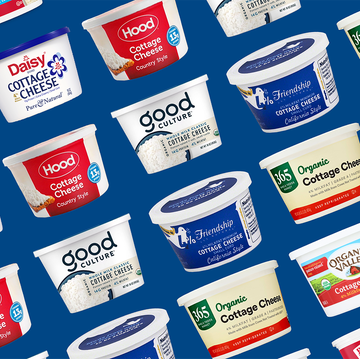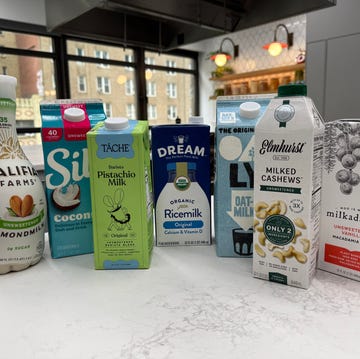Back in the days of Got Milk? posters, the word "milk" was synonymous with cow’s milk. Perhaps you had a rogue soy fan in the family or had to opt for a lactose-free version for digestive reasons, but for the most part, milk meant the classic white stuff in your fridge.
Now, the refrigerator section of many grocery stores is filled with an assortment of bottles of different "milked" ingredients: nuts, seeds, grains, you name it. And ordering a cappuccino at most coffee shops isn’t so simple these days, either. When asked what type of milk, you're met with options—sometimes too many!
Aside from types of milk, there are so many brands, each with their own recipes and methods. Unlike most dairy milk, a nutrition label on one brand's almond milk could be drastically different from the label on another's carton.
Many dietitians consider nutrient-dense cow’s milk the "gold standard," and it's often used as the benchmark for comparing the nutritional value of other milks. But you might abstain for ethical or health reasons, or like me, simply because you don't like the taste unless it’s masked by cereal or espresso. However, many plant-based milks don’t stack up quite the same nutritionally compared to cow’s milk. This is one of the reasons why the FDA has drafted guidelines for labeling plant-based milk and food alternatives.
So, how do you choose? Kristen Lorenz, R.D., and founder of KLL Nutrition, and Lauren Manaker, R.D., and consultant for the dairy milk advocacy group MilkPEP, share what to consider when buying milk and how common non-dairy milks compare to cow’s milk.
What To Consider When Buying "Milk"
When you select a carton of milk at the grocery store, you might be thinking about nutrition, but also important is the flavor, texture, and ultimately, what you’re using it for. Are you going to be drinking it by the glass as a source of protein, or are you looking for a low-calorie, neutral-tasting liquid to add to smoothies? Does it need to froth well in coffee drinks? Or, perhaps, you need a multi-purpose milk that hits most, if not all, of the boxes.
"Think of plant-based milks like pantry staples: different ones serve different functions, just like oils or flours," Lorenz says. When it comes to choosing the "best" milk, she says, "there’s no one-size-fits-all."
For protein and overall nutrition, she recommends cow’s milk or soy milk. If you’re looking for a low-calorie option, consider unsweetened almond milk or cashew milk. While I personally can’t deviate from cow’s milk for its perfect froth in a cappuccino, Lorenz recommends oat or coconut milk for its creaminess.
Navigating Non-Dairy Milk Ingredients
Take a look at any "milk" section at the grocery store and you’ll likely see several brands, each with different types of plant-based milks and different variations: sweetened, unsweetened, flavored, "barista edition," etc. This can make it difficult to talk about nutrition, as there’s not a standard nutritional baseline for oat milk or almond milk.
"Don’t judge a milk by its front label! Flip it over and read the nutrition facts," Lorenz says. "Look for short ingredient lists with fortification and minimal additives, especially if you drink it daily." The three primary things she looks at are protein, added sugars, and calcium and vitamin D fortification:
- Protein: If it’s a main source of protein, she says to pick something that has 7 to 8 grams per serving
- Added Sugars: Keep it under 5 grams per serving by picking unsweetened or lightly sweetened
- Contains Calcium & Vitamin D
Additionally, the FDA recommends choosing milks that are lower in saturated fats.
Manaker cited a recent study in the Journal of the National Academy of Nutrition and Dietetics, comparing the nutrition of 219 plant-based milk products from 21 brands to dairy milk. "While soy milk, especially when fortified, was found to most closely resemble the nutrient profile of dairy milk, there were significant variations in nutrients like protein, calcium, and vitamin D across plant-based milk options."
Many plant-based milks are known for their added ingredients, many of which aren’t almonds, oats, or soybeans. Some common added ingredients include gums, carrageenan, lecithin, and oils, which can serve as stabilizers or emulsifiers. "The simpler the label, the better," Lorenz says, who notes that fewer additives mean fewer digestive or allergy concerns.
While generally considered safe, she adds that high amounts of gums can be irritating and that carrageenan might cause GI discomfort for some. Some brands offer plant-based options without these added ingredients.
Below, you'll find a nutritional comparison for dairy milk and common non-dairy milk alternatives, along with pros, cons, and best uses for each.
Note: Nutritional content varies greatly between milk brands. For ease of nutrient analyses, we primarily used Survey Foods from the USDA’s FoodData Central and rounded values to the nearest whole number. Always check the label, as these figures can change from brand to brand.
Dairy Milk
While there are a lot of popular plant-based milks on the market, there seems to have been a noticeable resurgence of cow’s milk, which contains all nine essential amino acids, making it a complete protein. "Cow’s milk is naturally nutrient dense: It delivers high-quality protein, calcium, potassium, and vitamin B12," Lorenz says.
While the sugar (i.e., lactose) it contains is natural, it’s still worth noting for those who have to limit sugar in their diets. (However, if you’re just splashing it in your coffee rather than drinking it by the glass, the well-rounded nutrient profile of cow’s milk might not matter quite as much.)
Pros: Complete protein; minimally processed; no added sugar
Cons: Contains sugar; vegans or those with dairy allergies must avoid; saturated fat
Best Uses: Drinking plain, coffee, cooking, baking
Nutrition per cup of whole milk, per USDA:
- Calories: 149
- Fat: 8g
- Carbs: 11g
- Fiber: 0g
- Sugar: 12g
- Protein: 8g
Soy Milk
Due to its similar nutrient profile to dairy milk, soy milk fortified with vitamin A, D, and calcium is the only plant-based milk included in the dairy section of the Dietary Guidelines for Americans. Soy milk is considered a complete protein because it contains all nine of the essential amino acids.
"Nutritionally, soy milk is the closest plant-based equivalent to cow’s milk," Lorenz says.
Pros: Complete protein; high protein; nutrient-dense
Cons: Some contain gums
Best Uses: Alternative for cow’s milk; drinking by the glass
Nutrition per cup of soy milk, per USDA:
- Calories: 93
- Fat: 5g
- Carbs: 3g
- Fiber: 0g
- Sugar: 1g
- Protein: 9g
Almond Milk
"Almond milk is low in calories and protein, which can align with some nutritional needs or preferences," Lorenz says. While it might not be as nutritious as cow’s milk or soy milk, its subtle flavor and minimal calories make it an easy liquid for smoothies if you want a bit more heft than water. I also like using it in overnight oats.
Pros: Typically low in calories and carbs
Cons: Typically low-protein; higher protein blends can be more costly
Best Uses: Smoothies; overnight oats
Nutrition per cup of almond milk, per USDA:
- Calories: 37
- Fat: 3g
- Carbs: 1g
- Fiber: 0g
- Sugar: 0g
- Protein: 1g
Oat Milk
Oat milk has increased in popularity over the last few years. "Oat milk has a naturally creamy texture and more carbohydrates than other plant milks, benefiting those needing quick energy or avoiding nut-based options," Lorenz says.
But oat milk has also received its fair share of attention over its nutrition, namely its sugar content and glycemic index. During the production process of unsweetened oat milk, the natural glucose in oats is broken down into smaller molecules, creating simple sugars. This causes oat milk to have a higher glycemic index, a measure of how quickly something raises blood sugar levels, than regular oats. But it's more important to focus on glycemic load, Dr. Rosemary Trout, program director and associate clinical professor of Culinary Arts & Food Science at Drexel University, previously told Delish. This measurement evaluates the overall impact on blood sugar, considering the serving size and the combination of nutrients like fat and fiber. These elements can moderate blood sugar spikes.
Pros: Creamy; carb content can provide energy; alternative to nut milks
Cons: Higher in carbs and sugar; may spike blood sugar; might contain oils and gums
Best Uses: Coffee drinks; when you want a similar texture to cow’s milk
Nutrition per cup of oat milk, per USDA:
- Calories: 110
- Fat: 6g
- Carbs: 13g
- Fiber: 1g
- Sugar: 5g
- Protein: 2g
Coconut Milk Beverage
Don’t confuse this one with the canned version typically used in creamy curries and sauces. In the milk case, coconut milk is typically referred to as a "coconut milk beverage" because it's very different. It contains much less fat and isn't as thick. It still has a creamy texture, which Lorenz says is best used for cooking or coffee and not for getting protein.
Pros: Creamy texture; rich flavor
Cons: High in saturated fat; low in protein
Best Uses: Coffee; recipes
Nutrition per cup of coconut milk, per USDA:
- Calories: 76
- Fat: 5g
- Carbs: 7g
- Fiber: 0g
- Sugar: 6g
- Protein: 1g
Pistachio Milk
As a newer milk alternative, pistachio milk might not be as available as others, but those who like the flavor of pistachios might like it. "Pistachio milk is newer to the market and offers antioxidants and a buttery flavor, but it is low in protein and often pricey," Lorenz says.
Pros: Complete protein, although low in protein; antioxidants; buttery flavor
Cons: Low in protein; often expensive; some contain gums
Best Uses: Coffee
Nutrition per cup of pistachio milk, per USDA:
- Calories: 37
- Fat: 3g
- Carbs: 1g
- Fiber: 0g
- Sugar: 0g
- Protein: 1g
Cashew Milk
Similar to pistachio, cashew milk isn't quite as popular as other non-dairy milks, but it provides a great texture. "Cashew milk is very creamy and it works well in recipes or coffee, but like almond milk, it’s typically low in protein."
Pros: Creamy
Cons: Low in protein and other nutrients
Best Uses: Coffee; smoothies
Nutrition per cup of cashew milk, per USDA:
- Calories: 37
- Fat: 3g
- Carbs: 1g
- Fiber: 0g
- Sugar: 0g
- Protein: 1g
The Bottom Line
Ultimately, selecting which milk to buy depends on your health, dietary restrictions, and intended use.
"From my perspective as a dietitian, real cow's milk stands out as the healthiest option overall due to its naturally balanced nutrition," Manaker, who consults for an organization that promotes dairy milk consumption, says. "That said, if chosen mindfully, there can be a place for plant-based milks in a balanced diet, especially for those with dietary restrictions."
Soy milk and cow’s milk are the only two beverages included in the USDA’s Dietary Guidelines because of their well-rounded nutrient profile. But if you’re not consuming your preferred type of "milk" for its nutrients (and getting protein, vitamins, and calcium elsewhere), non-dairy milk alternatives can be a tasty and allergen-friendly part of a balanced diet.
"The healthiest milk is the one that fits your body's needs, tolerance, and budget," Lorenz says. To recap, here are the best options based on your specific needs:
- Protein and nutrition: cow’s milk, soy milk
- Low in calories: unsweetened almond or cashew milk
- Creamy texture for coffee: oat milk, coconut milk, pistachio milk, cashew milk
















